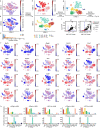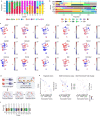Epigenomic diversity of cortical projection neurons in the mouse brain
- PMID: 34616065
- PMCID: PMC8494636
- DOI: 10.1038/s41586-021-03223-w
Epigenomic diversity of cortical projection neurons in the mouse brain
Abstract
Neuronal cell types are classically defined by their molecular properties, anatomy and functions. Although recent advances in single-cell genomics have led to high-resolution molecular characterization of cell type diversity in the brain1, neuronal cell types are often studied out of the context of their anatomical properties. To improve our understanding of the relationship between molecular and anatomical features that define cortical neurons, here we combined retrograde labelling with single-nucleus DNA methylation sequencing to link neural epigenomic properties to projections. We examined 11,827 single neocortical neurons from 63 cortico-cortical and cortico-subcortical long-distance projections. Our results showed unique epigenetic signatures of projection neurons that correspond to their laminar and regional location and projection patterns. On the basis of their epigenomes, intra-telencephalic cells that project to different cortical targets could be further distinguished, and some layer 5 neurons that project to extra-telencephalic targets (L5 ET) formed separate clusters that aligned with their axonal projections. Such separation varied between cortical areas, which suggests that there are area-specific differences in L5 ET subtypes, which were further validated by anatomical studies. Notably, a population of cortico-cortical projection neurons clustered with L5 ET rather than intra-telencephalic neurons, which suggests that a population of L5 ET cortical neurons projects to both targets. We verified the existence of these neurons by dual retrograde labelling and anterograde tracing of cortico-cortical projection neurons, which revealed axon terminals in extra-telencephalic targets including the thalamus, superior colliculus and pons. These findings highlight the power of single-cell epigenomic approaches to connect the molecular properties of neurons with their anatomical and projection properties.
© 2021. The Author(s).
Conflict of interest statement
J.R.E. serves on the scientific advisory board of Zymo Research Inc.
Figures















References
-
- Klingler, E., Prados, J., Kebschull, J. M., Dayer, A. & Zador, A. M. Single-cell molecular connectomics of intracortically-projecting neurons. Preprint at 10.1101/378760 (2018).
Publication types
MeSH terms
Grants and funding
LinkOut - more resources
Full Text Sources
Molecular Biology Databases
Research Materials

